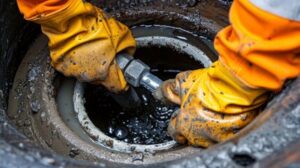San Jose Cabinet Refinishing involves changing the look of existing cabinets by staining or painting them. This option is best for homeowners who want to refresh the look of their kitchen without spending a fortune.

But refinishing isn’t always the right choice. If your cabinets are made from solid wood or Rigid ThermoFoil, refinishing isn’t possible.
Painting cabinets is the first step in a cabinet refinishing project and it can make or break your results. Proper surface prep, the use of a high-quality primer, and proper number of coats are essential to a long-lasting, durable finish.
Before you paint, clean your cabinet surfaces with a degreaser to remove grease buildup. This will help your new paint and primer adhere to the surface. You should also mask off countertops and appliances with painter’s tape to avoid stains and drips. Finally, cover floors with drop cloths to prevent paint and dust from spreading. It’s also a good idea to empty your cabinet drawers and doors so that you can work on them more easily. Taking this small step will help you avoid confusion when you reassemble your cabinets later on.
The most common mistake people make when painting their cabinets is not priming them first. This can be a costly error because the finish will peel or chip if the paint isn’t properly attached to the surface. A quality primer, like KILZ 3(r) PREMIUM Primer, provides excellent adhesion and resists mildew growth in moisture-prone areas.
It’s also important to lightly scuff sand the surface of the cabinet before you paint. This will help the primer and paint grip the surface, preventing it from bubbling or peeling later on. You can sand by hand with medium-grit sandpaper, or you can use an electric sander to save time and effort.
Before you begin sanding, it’s a good idea to empty your cabinet drawers so that you can work on them more easily. It’s also a good idea take this opportunity to empty the contents and place them in a labeled plastic bag for later reinstallation. You should also use this time to inspect your cabinet door and drawer fronts for any dents or gouges that can be repaired with wood filler. These imperfections will be visible after you re-hang the doors and drawers, so it’s worth taking the extra time to make them look their best.
Stain
Cabinet staining emphasizes the natural beauty of wood, providing a more authentic look. Compared to paint, it requires less maintenance and hides fingerprints and minor wear much better. Stains also come in a wide range of color options to match any interior design vision. When it comes to staining, there are two main types: water-based and oil-based. Water-based stains offer minimal color change and emit fewer fumes, making them the preferred choice for most indoor applications. Oil-based stains, however, offer more color choices and penetrate deeper into the wood fibers for a more durable finish.
Regardless of which type of stain you choose, it is important to thoroughly clean the cabinets prior to application. Professionals typically use trisodium phosphate (TSP), which can be purchased as a ready-to-use spray or in powder form to be diluted with water according to the manufacturer’s instructions. Using TSP to wash doors and cabinet exteriors helps create a smooth surface that will allow the stain to adhere to the wood.
TSP also works well for removing grease and grime from the kitchen environment, which can otherwise be difficult to remove with regular cleaning. After sanding the cabinets, it is important to wipe away any excess TSP residue and then dry the surfaces using a soft cloth. Depending on the type of stain you select, you may need to apply several coats for an even, uniform appearance.
After the stain is applied, it is important to seal the cabinets with a high-quality polyurethane or lacquer. A quality finish provides additional protection from moisture and offers durability that can extend the lifespan of your cabinets for many years to come.
Staining and painting are essential aspects of cabinet refacing, but it’s critical to work with a professional to ensure an even, seamless result. The team at Top Refinish will guide you through the process to revitalize your cabinets with a customized transformation that perfectly matches your interior design vision. Contact us to learn more about our cabinet refinishing services today!
Varnish
Varnish is the final step in the cabinet refinishing process, and it’s an important one. It helps protect the new stain and finish from water damage and sunlight. It also makes the cabinets look more beautiful. The best varnishes for cabinets are water-based because they dry quickly and are easy to clean up. Water-based varnishes are also healthier for the environment.
Before applying the varnish, make sure to wipe down the cabinets with a damp cloth to remove any remaining dust or dirt. Then, sand the cabinets with fine-grit sandpaper to create a smooth surface. Be sure to wear a mask while doing this, as sanding can produce a lot of dust. Once the sanding is complete, wipe down the cabinets with a damp cloth again to remove any dust and dirt.
The final stage in the cabinet refinishing process is to apply the clear varnish. There are many different types of varnish, and each type has its own advantages and disadvantages. Choose a varnish that is suitable for your project and the climate where you’re working. It’s best to work in a well-ventilated area, and avoid using fans to speed up the drying time.
A varnish is a liquid coating material that contains a mixture of resins, oils and solvents. When it dries, it forms a hard transparent film that protects wooden surfaces and enhances the appearance of paintings and decorative objects. Most varnishes are oil-based, but some contain synthetic materials to improve flow and help them dry faster. Oil-based varnishes are toxic, requiring precautions against inhalation and skin exposure. Water-based varnishes are safer, but they can still cause respiratory problems if the fumes are inhaled or the skin is exposed.
Varnish is an HTTP caching system that stores copies of web pages, video segments and APIs in memory and on disk. When a user requests a piece of content, Varnish delivers the cached copy rather than the original, which saves resources on the server and gives users a much faster experience. It also prevents the need to generate and serve new content from the origin, reducing network loads and improving performance.
Hardware
Cabinet hardware is essential to both the appearance and functionality of cabinetry. From the visible handles that are attached to the doors and drawers to the hinges and slide hardware you invest in to make sure they operate smoothly, this type of cabinetry element can make or break your overall design goals for your room. There is a wide variety of cabinet hardware available, including everything from traditional to modern and sleek to industrial. This allows you to make a subtle statement with your new hardware, or you can opt for something a little more eye-catching to add personality and contrast to your cabinetry.
Choosing the right hardware to match your existing cabinets can be a bit overwhelming as there are so many options to choose from, but it is important to keep in mind your design goals and the overall style of your space when selecting new cabinet knobs or handles. It is also important to choose hardware that complements the finish of your cabinetry; for example, if you are using nickel cabinet hardware, it’s important to choose between polished or brushed metal, and not mix finishes, as this can look jarring and disjointed.
The key benefits of cabinet refinishing include improved aesthetics and a fresh, updated color scheme that can transform the overall look of your kitchen or bathroom. Additionally, refinishing can be more budget-friendly than replacing your entire cabinetry and it can be done in a much shorter amount of time.
Refinishing can be a dangerous job to perform at home, especially without the proper equipment and knowledge. The process involves working with chemicals that can be harmful if not used in the correct way or in a properly ventilated area. A professional refinishing company has the tools and safety gear needed to safely complete this type of project, which reduces the risk of injury and health problems for you and your family.
Cabinet refacing is an alternative to refinishing that involves removing the old doors and drawer fronts, removing any damaged cabinet boxes and reinstalling them. This type of cabinet remodeling is more costly than refinishing, but it can provide a more dramatic transformation and is ideal for older cabinets with damaged components like warped doors or faulty hardware.
